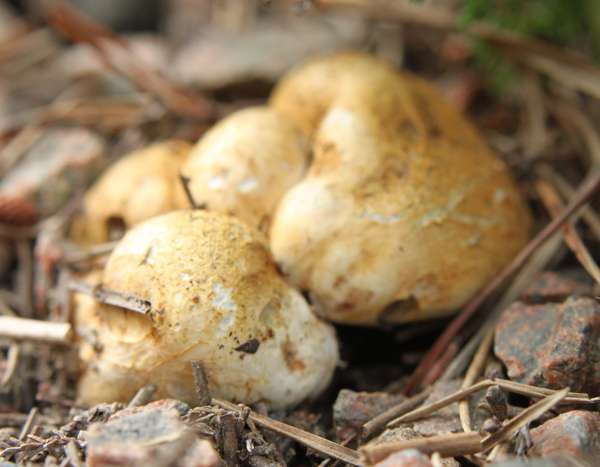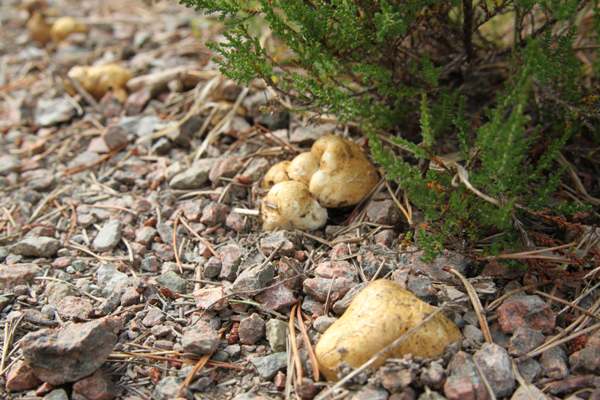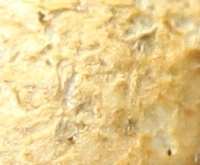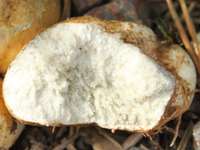Rhizopogon luteolus Fr. & Nordholm - Yellow False Truffle
Phylum: Basidiomycota - Class: Basidiomycetes (Gasteromycetes) - Order: Boletales - Family: Rhizopogonaceae
Distribution - Taxonomic History - Etymology - Identification - Culinary Notes - Reference Sources

Now known to be closely related to boletoid fungi and in particular those of the family Suillaceae, the Yellow False Truffle is another demonstration of just how artificial the gasteromycetes grouping is; indeed, this term has no taxonomic significance and is retained for historical reasons and for the convenience of mycologists who like to study the various 'stomach fungi', as they are sometimes called. Puffballs, earthballs, stalkballs, stinkhorns and earthstars are all included in the artificial grouping known as the gasteromycete fungi.
Rhizopogon luteolus is called the Yellow False Truffle because it is yellow and it looks like a truffle. These false truffles are nowhere near as difficult to spot and true truffles; that's because Rhizopogon luteolus and its close relatives tend to push their way up above the surface as the fruitbodies expand - so there's no need to buy a pig just to find these rather unspectacular fungi.

Distribution
Seen only occasionally in Britain and Ireland except for the far north of England and throughout Scotland, where it is a fairly common sight in pine forests on sandy soil, Rhizopogon luteolus occurs also throughout most of mainland Europe, but again it is common only in sandy pine-forested parts of northern Europe. Yellow False Truffles are also quite common in Australia, where these mycorrhizal fungi were introduced early in the 20th century to improve productivity of pine forests there.
Taxonomic history
When Swedish mycologists Elias Magnus Fries and Johan Nordholm first described this fungus in 1817 they gave it the binomial scientific name Rhizopogon luteolus, and that is the name by which it is known today. It was not always so, however: not long after Fries and Nordholm had named this species, Carlo Vittadini (1800-1875) and other mycological authorities were treating the genus Rhizopogon as ascomycetous rather than, as it certainly is, basidiomycetous. Its taxonomy has been a challenge ever since, and only recently has its affinity with the family Suillaceae been uncovered.
Synonyms of Rhizopogon luteolus include Rhizopogon induratus Cooke.
Etymology
Rhizopogon, the generic name, comes from Rhiz- meaning root, and -pogon, meaning beard. You might therefore expect the false truffles in this genus have root-like appendages that look rather like beards hanging down from a chin. They are indeed attached to the ground (and ultimately to the roots of pine trees) by pale mycelial cords. (In Western USA there are more than 100 Rhizopogon species, but in Britain only half a dozen species have been found so far.)
The specific epithet luteolus refers to the yellow colouring of these potato-like false truffles.
Identification guide
 |
DescriptionLooking very much like a potato and just as variable in size and shape, the Yellow False Truffle is typically 1.5 to 4.5cm across its largest dimension and can be ovoid, ellipsoidal, an oblate spheroid or a lobed blob... shapeless is the term that most readily comes to mind! There is no stem, but cord-like mycelial threads spread into the soil (and to tree rootlets from a central point under the fruitbody. Its outer skin is tougher than the interior tissue, and it is off-white initially but soon turns ochre and eventually olive brown. The outer surface, which usually cracks irregularly as the fruitbody expands, is often randomly decorated with tawny mycelial strands that give it a slightly woolly appearance. |
 |
Internally the spore-bearing gleba of Rhizopogon luteolus is almost white at first (pictured on the left), turning ochre and eventually olive brown as the spores approach maturity. The interior of the fruitbody comprises many tiny chambers lined with basidia, upon which the spores develop; initially the interior is soft and spongy, becoming dry and powdery when old. |
SporesOblong-ellipsoidal, 7-10 x 2.5-3.5µm; covered with an irregular coarse reticulum. Spore massCreamy white or yellowish. |
|
Habitat & Ecological role |
Yellow False Truffles generally occur either singly or, more commonly, in small groups in pine woodland on sandy soil, often beside forest tracks. Rhizopogon luteolus is ectomycorrhizal with pine trees. |
Season |
Late summer and autumn in Britain and Ireland. |
Similar species |
Pisolithus arrhizus, the Dyeball Fungus, is darker and much larger; it, too, is mycorrhizal with pines. |
Culinary Notes
Unlike Tuber species (the true truffles), which are edible and highly prized, the Yellow False Truffle Rhizopogon luteolus is of disputed edibility. While many authorities describe it as edible (albeit not highly regarded), others including Roger Phillips and Leif Goodwin list it as inedible. We have no first-hand experience of eating this particular species and we know of no reports of people experiencing adverse reactions to it either.
Reference Sources
Fascinated by Fungi, 2nd Edition, Pat O'Reilly 2016, reprinted by Coch-y-bonddu Books in 2022.
Manfred Binder & David S. Hibbett, Molecular systematics and biological diversification of Boletales. Mycologia 98 (6), pp 971–981; 2006.
Smith, A H and Zeller S M, 1966 A preliminary account of the North American species of Rhizopogon. Mem New York Bot Gard 14:1- 178
Lisa C Grubisha et al. Biology of the ectomycorrhizal genus Rhizopogon. VI. Re-examination of infrageneric relationships inferred from phylogenetic analyses of ITS sequences; Mycologia July/August 2002 vol. 94 no. 4 pp 607-619.
Dictionary of the Fungi; Paul M. Kirk, Paul F. Cannon, David W. Minter and J. A. Stalpers; CABI, 2008
Taxonomic history and synonym information on these pages is drawn from many sources but in particular from the British Mycological Society's GB Checklist of Fungi.
Fascinated by Fungi. Back by popular demand, Pat O'Reilly's best-selling 450-page hardback book is available now. The latest second edition was republished with a sparkling new cover design in September 2022 by Coch-y-Bonddu Books. Full details and copies are available from the publisher's online bookshop...

